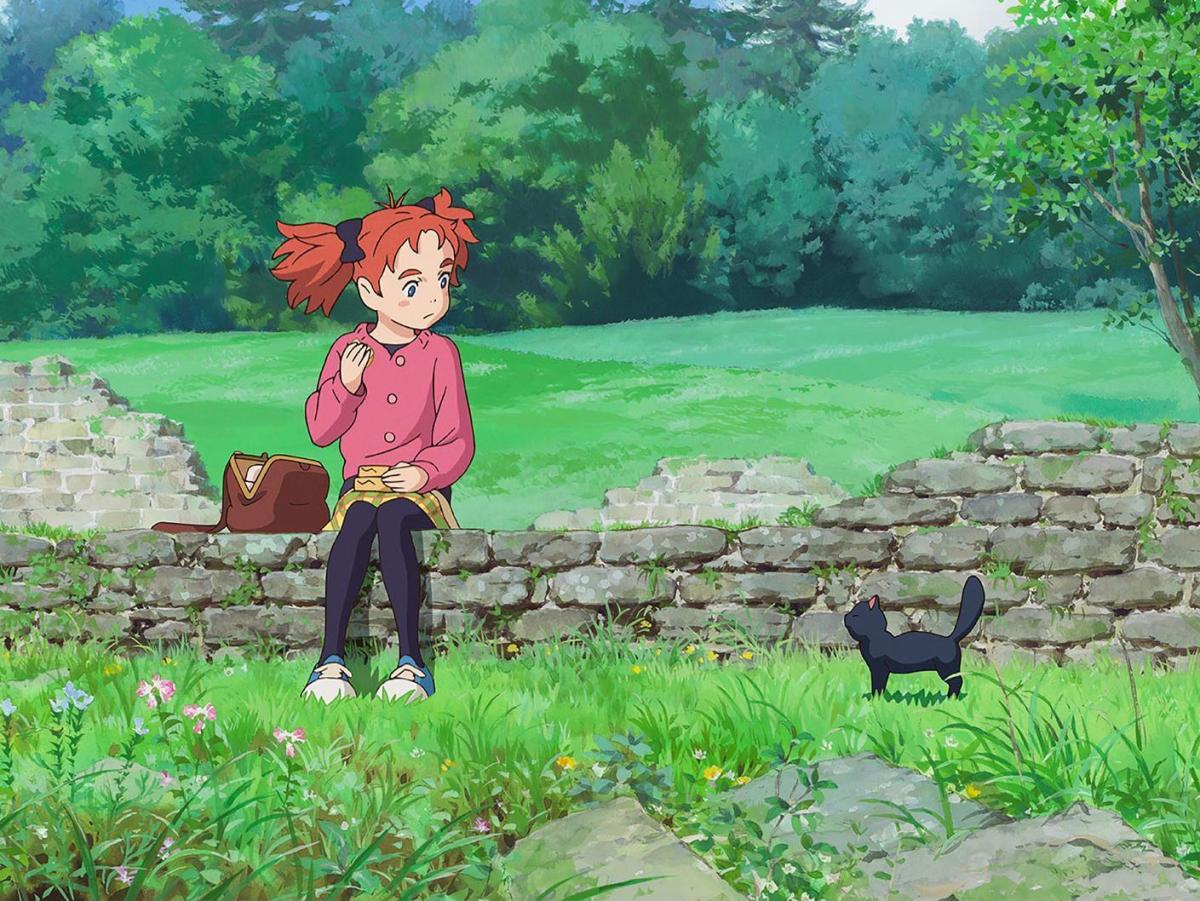Image: Studio Ponoc’s Mary and the Witch’s Flower.
From beloved Japanese animation house Studio Ghibli, much has blossomed: a three-decade career, 21 enchanting features, global fandom, and a cult following for co-founder Hayao Miyazaki. Mary and the Witch’s Flower joins them, though it’s actually a Studio Ponoc production. Helmed by former Ghibli animator turned The Secret World of Arrietty and When Marnie Was There director Hiromasa Yonebayashi, it’s the first feature from his new outfit; however the debt owed to the company’s predecessor is immediately obvious.
It’s with fire and a frenzy that Mary and the Witch’s Flower opens, as a flame-haired girl attempts to escape the clutches of nefarious foes attempting to keep a blue flower for themselves. Post-prelude, audiences soon meet Mary (Hana Sugisaki, Blade of the Immortal), who proves restless as she awaits both her parents’ arrival at her Great-Aunt Charlotte’s (Shinobu Ôtake, Our Little Sister) country home, and her first day at her new school. The only person anywhere near her own age is the teasing Peter (Ryûnosuke Kamiki, Your Name), who makes fun of the locks she already hates, while neither housekeeper Miss Banks (Eri Watanabe, Guardian of the Spirit) or gardener Zebedee (Ken’ichi Endô, The Mole Song: Hong Kong Capriccio) need her help. Chasing a cat into the adjacent forest alone, that’s how she comes across the azure blossoms with magical powers – and finds herself on the way to Endor College on a flying broomstick.
As certain as Chihiro was whisked off to a realm unlike her own in Ghibli classic Spirited Away, Mary becomes immersed in her new surroundings, where trainee witches hone their skills under the guidance of Madam Mumblechook (Yûki Amami, Emergency Interrogation Room) and Doctor Dee (Fumiyo Kohinata, Fullmetal Alchemist). And, as certain as Alice learned that Wonderland didn’t always live up to its name in the tale that continues to pulse through many that follow, Mary soon discovers the darker side of her adventure. The film adapts Mary Stewart’s 1971 children’s book The Little Broomstick, but the approach favoured by writer/director Yonebayashi and his co-scribe Riko Sakaguchi can’t escape its similarities to other well-known journeys. Indeed, spying commonalities with Kiki’s Delivery Service and the Harry Potter franchise is easy, and stems from more than just overlapping narrative elements.
In its charming tone, colourful appearance and dream-like air, Mary and the Witch’s Flower whole-heartedly treads where others have previously – and with purpose. From colourful frames filled with unusual creatures and structures, to the visual and emotional rush of zooming above the treetops, to adorable animal offsiders, there’s much that’s familiar in a movie aware of the history it’s wading into, with its recognisable aspects extending to the underlying search to belong. And yet, while surprises mightn’t flow frequently, Yonebayashi once again demonstrates his key eye for detail. As well as being compelled to bring decades-old British kids’ novels to the screen, he’s drawn to the splendour of the worlds within them. Accordingly, predictable though Mary’s flight path may be, she soars through gorgeously, intricately realised territory, whether frolicking through and over the woods, or grappling with loneliness and acceptance.
Of course, at the heart of every youthful wander into magical terrain sits a well-trodden quest to understand one’s place in the world, particularly as childhood threatens to slip away when teenage years encroach. That’s true of Mary and the Witch’s Flower in an involving and astute manner; the end result doesn’t demonstrate the complexity of recent Japanese hit Your Name, or reach the heights of Ghibli’s soulful roamings, but it understands and expresses how change can breed uncertainty – and how getting the confidence to adjust, act and soldier onwards is a complex process. The vocal stylings of the Japanese-language cast assist effectively and movingly, particularly Sugisaki’s ability to convey Mary’s inner feistiness and fears all at once. In the English-dubbed version, The BFG’s Ruby Barnhill faces off against Kate Winslet (Wonder Wheel) and Jim Broadbent (Paddington 2).
Rating: 3 stars out of 5
Mary and the Witch’s Flower
Director: Hiromasa Yonebayashi
Japan, 2017, 102 mins
Release date: January 18
Distributor: Madman
Rated: PG
Actors:
Director:
Format:
Country:
Release:





